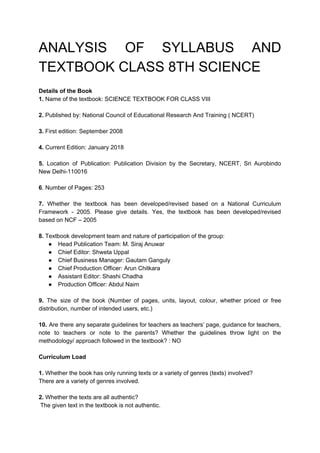
Analysis of syllabus and textbook class 8 th science
- 1. ANALYSIS OF SYLLABUS AND TEXTBOOK CLASS 8TH SCIENCE Details of the Book 1. Name of the textbook: SCIENCE TEXTBOOK FOR CLASS VIII 2. Published by: National Council of Educational Research And Training ( NCERT) 3. First edition: September 2008 4. Current Edition: January 2018 5. Location of Publication: Publication Division by the Secretary, NCERT, Sri Aurobindo New Delhi-110016 6. Number of Pages: 253 7. Whether the textbook has been developed/revised based on a National Curriculum Framework - 2005. Please give details. Yes, the textbook has been developed/revised based on NCF – 2005 8. Textbook development team and nature of participation of the group: ● Head Publication Team: M. Siraj Anuwar ● Chief Editor: Shweta Uppal ● Chief Business Manager: Gautam Ganguly ● Chief Production Officer: Arun Chitkara ● Assistant Editor: Shashi Chadha ● Production Officer: Abdul Naim 9. The size of the book (Number of pages, units, layout, colour, whether priced or free distribution, number of intended users, etc.) 10. Are there any separate guidelines for teachers as teachers’ page, guidance for teachers, note to teachers or note to the parents? Whether the guidelines throw light on the methodology/ approach followed in the textbook? : NO Curriculum Load 1. Whether the book has only running texts or a variety of genres (texts) involved? There are a variety of genres involved. 2. Whether the texts are all authentic? The given text in the textbook is not authentic.
- 2. 3. Are there any illustrations? If yes, do they support the concepts/ideas conveyed in the text? Yes 4. Whether the textbook presents local contexts in terms of visuals, texts and presentation? Yes, all the chapters. 5. Whether the book is divided into a subdivision of sections for making easy and coherent progression? Yes, the book is divided into a subdivision of sections for making easy and coherent progression Pedagogical Aspects 1. Whether the textbook uses contemporary language in rubrics (i.e. the instructions)? Yes, the textbook uses contemporary language in rubrics. 2. Is there coherence within the textbook (from unit one to the last unit)? Yes, all the chapters because it is given section wise i.e physics, chemistry, biology 3. Whether the teacher is able to understand the philosophy of the book (the approach to language teaching-learning like constructivism, communicative language teaching, whole language perspective, etc.) through the teacher’s pages or through the activities. Yes, the teacher is able to understand the philosophy of the book and through the teacher’s pages activities early connected to children. 4. Whether the language of the textbook is simple and comprehensible to the learners and teachers? Yes, the language of the textbook is simple and comprehensible to the learners and teachers. 5. Whether the tasks and activities give scope for engagement with language? This means how much time the learner is asked to spend on a task doing and thinking about language and the ideas of the tasks. Yes, the tasks and activities give scope for engagement with language. 6. Whether the tasks/activities create anxiety in the learners and the teacher? Yes, the tasks/activities create anxiety in the learners and the teacher. The activities of the chapter give create by learners.
- 3. CHILD CENTREDNESS The Language of the Textbook: 1. Whether the themes are related to the lived-in experiences of learners? Whether the units/lessons make attempts to connect with the lives of learners? Yes, themes are related to the lived-in experiences of learners. Yes, the units/lessons make attempts to connect with the lives of learners. 2. Self-learning is evaluated through an adequate number of questions and explanation of concepts/topics covered in the book. The scope of self-assessment is limited in textbooks mainly it provides answer keys of unsolved problems. 3. The questions are given in exercises of the textbook cover all the concepts of the relevant topic. There are a variety of questions in each textbook which provide opportunities for reflection for the child. Yet the questions of textbooks based on inductive thinking are required more. 4. The textbook has an adequate number of problems/exercises. Most of the exercises promote practising a concept rather than creativity or skills development. 5. Almost all activities are related to real-life experiences and contexts of the children Overall observations: This textbook is prepared to keep in mind NCF – 2005. The opportunity for the students of self-learning is given. Suggestions 1- There were no questions on entry behaviour and expected outcomes for any chapters throughout the book. The chapters were introduced by recalling the work done in standard 7. Expected learning outcomes are important, as it helps the teachers to know how far students have followed the topic. It is an instrument for measuring how much students have followed on completing the chapter. 2-The present curriculum should be reviewed according to In the needs of the learners and the teachers with suitable provision for refreshment courses for science teachers in English also. 3-The teachers who write textbooks should have knowledge and experience of teaching in that particular class, to know the level of students of that particular age group. 4-The physical aspects of the textbooks should be improved i.e. cover design, binding of the book, papers used in the book. If the cover page is attractive then students are also attracted to the books.
- 4. 5- There should be some higher-level cognitive categories of questions (examples) in the exercises of standard 8th textbooks. 6- Exercises should be enriched with adequate examples of different categories of the cognitive domain according to Bloom’s taxonomy.